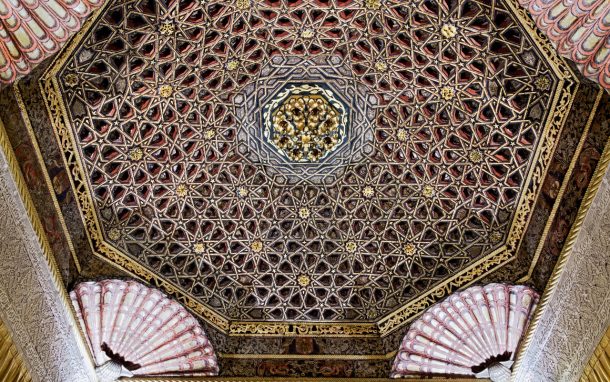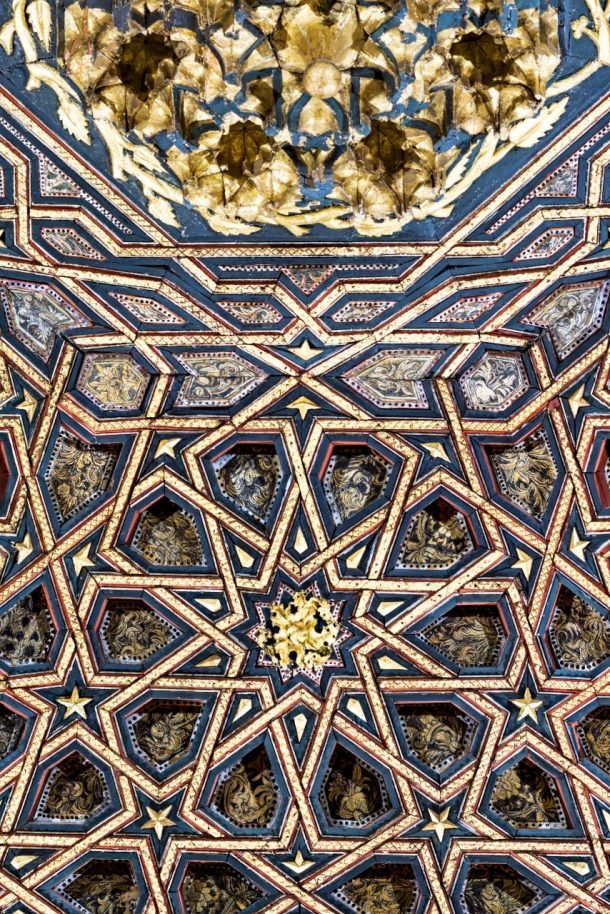In our blog series so far, we have described the histories of three of the four Torrijos ceilings – at the V&A in London, the Museo Arqueológico in Madrid, and at the Legion of Honor in San Francisco. The fourth of these ceilings, now at the Château Villandry in the Loire Valley, France, is the subject of this post. I was lucky enough to visit it in the summer of 2019, on a long hot day when tourists were flocking to the Renaissance-style gardens for which the Château is now very well known. The present-day owner is Henri Carvallo, and it was his great grandparents who purchased the ceiling and brought it to France over a century ago.


The ceiling
The Villandry ceiling is similar in form to the ceilings at the V&A and San Francisco. It has a central octagonal form of eight trapezoidal panels decorated with carved and painted geometric shapes formed from stars, with friezes linking shell-shaped squinches beneath, followed by a lower carved plaster frieze.

At the centre of the wooden ceiling is a large gilded muqarnas boss, beneath which the eight panels (faldones) support three and a half horizontal rows (from top to bottom) of ten-pointed stars, with each row comprising a ring of eight star wheels (‘ruedas’) while the eight half stars occupy the octagonal corners. The zafates are largely recessed and painted with black beading on white ground, filled with gold and black vegetal motifs. The tracery that outlines the star forms is gilded and outlined with red, white and black, while the stars are carved and gilded. Given the poor original state of the ceiling, the bright colour of the painting and gilding indicate the ceiling was restored, most likely after it reached Villandry.

Beneath the geometric octagonal section is a running frieze of gilded and carved chains that interlock with the ‘S’s. The ‘S’ motif refers to the relationship of the Cárdenas couple to the Spanish royal family (as we have discussed in our previous posts on the other ceilings). The chain may reference the freeing of Christian prisoners after the Christian conquest of Granada, an event that was celebrated by chains displayed on the exterior of the convent of San Juan de los Reyes in Toledo, a building that was contemporary with and hugely influential on the Cárdenas couple and the building of Torrijos palace.
The frieze sits above the four corner squinches, which take shell-like forms and are painted with red and black, and gilded. Two levels of painted wooden friezes link the four corners of the ceiling squinches. The upper level carries the coats of arms of the patrons, Teresa Enríquez and of Gutierre de Cárdenas, each flanked by a pair of putti carrying vegetal scrolls. The lower painted frieze includes the ‘S’ motif interspersed with thistles and vegetal scrolls. The wooden ceiling sits above a plaster frieze, which I will discuss more below.
The ceiling in Torrijos
The ceiling was most likely situated in the southwest corner room on the first floor of the Torrijos palace. It was described in the 1902 article in Por Esos Mundos, the article that effectively advertised the contents of the palace when it came up for sale (see our post about this history, here), as an octagonal ceiling that was simple in form and detail and accompanied by a frieze with ogival tracery beneath. A photograph of the part of the ceiling, showing its original plasterwork, accompanies the article.

That plasterwork did not survive the move from Torrijos. It was probably in too poor a condition for dismantling. In his 1961 book La Arquitectura Española en sus Monumentos Desaparecidos, Juan Antonio Gaya Nuño described how the walls and roof of this tower room were found in a poor condition and covered with lime whitewash when it was dismantled. The ceiling was dismantled alongside the rest of the palace contents before 1904.
The move to Château Villandry
How did the ceiling end up in a palace in the Loire valley? Château Villandry is a magnificent 16th-century palace on the Loire river near Tours, widely known for its Renaissance-style gardens that were renovated in the 20th century. The palace was built on medieval castle foundations in the 1530s, commissioned by Jean le Breton (1490 – 1542), who was minister of finance to the French king François I.

It was bought in 1906 by a Spanish doctor and American heiress, who married in 1899 and were ambitious in their plans to renovate the chateau and its gardens. Joachim (Joaquín) Carvallo (1869 – 1936) from Badajoz in Spain and American Ann Coleman (d.1940) used money she had inherited from the US steel industry to buy Villandry for 120,000 francs. In 1908 they began a lifetime’s work renovating the palace and gardens. Joachim was an avid collector of Spanish art, particularly 17th-century paintings, and he may have bought the Torrijos ceiling during one of his purchasing trips to Spain. Henri Carvallo, his great grandson and the owner of the palace today, tells the story that the ceiling was bought in an ‘outdoor market in Toledo’, but no further details on this purchase have come to light.

Carvallo and Coleman installed their Spanish ceiling in a dedicated corner room in the upper floor of Villandry, at the end of a gallery where it was on view when the house was opened to the public in 1920. Interestingly, it is the only one of the four ceilings to reside in a context similar to that of Torrijos, in a corner room of a private palace, now open for visitors to admire.

The ceiling was installed with a plaster frieze beneath it, but this was not the original one with which it was photographed in Torrijos. Neither is it a cast of that original frieze. Intriguingly, the frieze that came with the ceiling is identical to the cast panels that accompanied the V&A ceiling – however, in Villandry they do not include the Arabic inscriptions that run around the base of the plaster frieze below the V&A ceiling.

This indicates that at some point in time, after the palace was dismantled by July 1904 and before the ceiling arrived in Villandry, after 1906, a cast was taken of the plasterwork beneath the V&A ceiling and this was sold alongside the Villandry ceiling to Joachim Carvallo. Possibly the Villandry ceiling may have been handled by the same dealers in Toledo as those who sold the V&A ceiling along with its original and cast plaster panels to the museum in London – namely, Lionel Harris of the Spanish Art Gallery. New information that has come to light from our archival research with colleagues in the Hispanic Society of America indicates that these same dealers also sold the ceiling to Charles Deering, which eventually came to reside in the Legion of Honor. Might this same dealer have in fact handled all four ceilings, including the media naranja dome sold to Platón Páramo that is now at the Museo Arqueológico in Madrid?
Some of this new research will hopefully be the subject of another post coming soon, so we will save the details for then!


